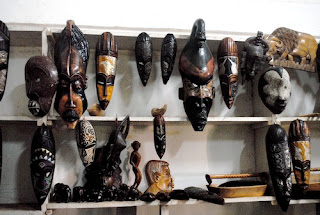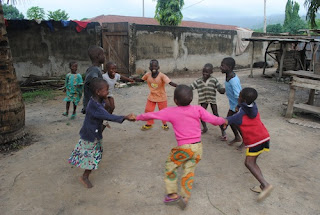Marcella got here yesterday for the week in order to revamp product design with Chantal to make her products more marketable, practical, durable, and easier for large-scale production. Marcella is such a fascinating woman and I’m so excited to learn from her and hear about all of her stories from her worldly travels and interesting job experiences. She’s originally from Colombia but has worked as a journalist, consultant, and designer and has had some of the most amazing life experiences. I want her life. When you are young, sometimes the best thing you can do is find the best leaders and follow them. So I’m going to ask her about her path taken, and how I can start out on my own. But before Marcella, which I’ll get to after this week, there was a day in the marches of Lome, which deserve their own mention.
Ashley had heard through the Peace Corps grapevine about the fetish market, a place where products for animism, voodoo, and fetishism join forces to supply for the traditional rituals of Togo’s ongoing animism adherents—a mere 40% of the population. We pulled up into the center of a large square, stalls framing both sides of the car. The second our car drove into the market, young boys came sprinting out of back rooms through the aisles, hands outstretches, hissing and pointing. It really freaked me out because even though I get hissed at all the time, it’s not like this, and it’s not in a fetish market. Stepping out of the car the first thing that hit me was the stench. I glanced around and it was then that I noticed all of the animal carcasses on the tables. There was a dead dog stretched out and drying on the ground a few feet away; I thought I was going to puke. After extensive price negotiation, and some effective pouting by Ashley, we got the chief to show us around the market and explain some ancient rituals. The primary way in which animism is still practiced is for medicinal purposes, and they grind up various parts of animals to remedy different illness. The puffer fish, for example, is used to treat elephantitus, which seemed a little bit too obvious for me, but I’m not going to disparage African voodoo, because I’m not trying to get cursed. He spoke of how the warriors wear necklaces of python vertebrae to give them strength in battle, how devotion to fertility statues will protect against maternal mortality, and all about the magical properties of horsehair. It was creepy, but fascinating at the same time. All the more interesting was that in the States, these practices would be written off as crazy and immoral cult rituals, but here, they’re not only accepted, but also given credence by a large portion of the population. Modern day medicine and healthcare, which access to is taken for granted in the west, hasn’t taken root in much of the developing world, partly because of a lack of access to adequate medical care in rural areas, as well as a lack of an ability to pay, so the poor have had to either make due with traditional remedies, or suffer in neglect.
But I digress, and the fetish market was making me increasingly uneasy and nauseous, so Ashley and I decided to go to the grand marché to do some lighter shopping and to find lunch—vegetarian, for obvious reasons. This was my second trip to Lomé’s market and so I was ready for it and not as completely overwhelmed. Lomé’s market is like Kpalimé’s, but on crack. It’s bustling and congested with people, goods, and cars, and navigating it is a nightmare if you don’t know where you’re going. Thank god for Ashley. But it also has the best variety of raw materials, pagne, food, jewelry, artisan craft, and most other goods imaginable. We found a woman to make us avocado sandwiches and then went to see the Mama Benz, women who sell huge quantities of pagne in the market, fittingly named because their success enables them to all drive Mercedes. They have some beautiful prints, but what on earth would I do with 12 yards of fabric, as they don’t sell it in smaller quantities, and I’ve already stocked up on pagne in Kpalimé and batik from Chantal. So we left and went to Ashley’s hidden gem of a seamstress, who is making me clothes from all of the fabric I’ve bought. Whoops. I can’t wait though, she’s making me some amazing stuff and I’ll definitely post pictures, but it won’t be finished until the day before I leave.
Right now I’m going over to Ashley’s to work with her, Marcella, and Chantal on our first session for product design. Marcella said it’s going to be a very organic process, and we are going to try and look into using organic, locally composed dyes, sourcing other raw materials such as distressed leather and canvas, and try and simplify designs for Chantal so that she can perfect these bags and really start to build up an inventory stock. I’m so excited and I know this week is going to be amazing. Tuesday we’re showing Marcella around the market here in Kpalimé, Wednesday I’m teaching the quality control curriculum I wrote, Thursday I’m conducting control group surveys, and Friday we’re spending all day at Chantal’s to finish up construction of all of the bags she’s going to be sending with Marcella to Nest as samples. I’ll keep you posted!

























































